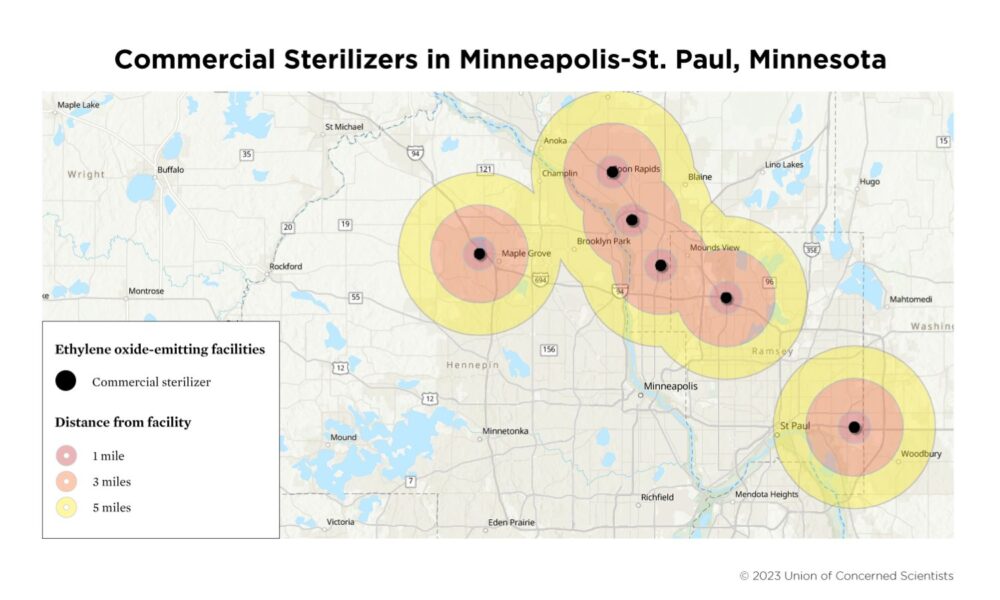Lately, I have been writing a lot about cumulative impacts from environmental hazards. Meanwhile, the Union of Concern Scientists just published an important report on the potential threat posed by emissions of ethylene oxide from facilities that use the cancer-causing gas to sterilize medical equipment and other products. The report includes case studies of hotspots for ethylene oxide emissions (including in Minnesota) and an interactive map. This analysis is strong and important work. And, as I’ll try to show, these two subjects have a lot in common.
What is the situation in Minnesota?
The state of Minnesota uses EPA’s ethylene oxide emissions standards, which haven’t been updated since 2006. These standards no longer adequately protect the public. EPA’s own scientists concluded in 2016 that the risk value of ethylene oxide is 60 times more toxic than previously understood. While the agency has failed to update the rule as required under the Clean Air Act, last year, EPA identified 23 “elevated cancer risk” commercial sterilizers and is currently working to inform communities and work with state regulators and the facilities to decrease emissions. But much more is needed.
So, what does this have to do with Minnesota? And what about cumulative impacts? Well, when the EPA reviewed the 23 facilities, they reviewed them one at a time and none of the facilities in Minnesota were on the highest emitter list. But, the EPA analysis neglected the fact that sterilizer facilities emitting ethylene oxide might be within close proximity to one another. Looking at the data this way, we see that there is a cluster of five facilities in the northwest suburbs of the Twin Cities all emitting the same carcinogenic gas. Looking at more than one facility at a time, even if you are only considering one chemical at a time, is a step towards addressing the cumulative impacts of pollution. And by considering multiple facilities at a time, this UCS report shows that Minnesota should act to reduce ethylene oxide emissions to protect public health.
In the EPA’s analysis, computer models were used to estimate air concentrations of ethylene oxide around facilities. These air concentrations were compared to “inhalation unit risk values”, to estimate a potential number of cases of cancer in a population of people. So-called “acceptable levels of risk” are informational tools used to either require or ask facilities to reduce emissions, depending on the regulatory authority that applies. The EPA used a cancer risk guideline of 100 additional cases of cancer in a population of one million as a prioritization tool to pick the first 23 facilities to work on. But the state of Minnesota uses a lower risk guideline—10 additional cases of cancer in a population of one million—to identify facilities to work with to reduce air toxics emissions. The Minnesota facilities each reported emitting ethylene oxide levels that translate to between 20 to 50 additional cases of cancer in a population of a million people. So, the facilities emissions exceed the levels that ought to be prioritized in Minnesota.
What is ethylene oxide and why should I be concerned?
Ethylene oxide is a colorless gas that is used to sterilize medical equipment, plastics, packaged spices, and to make ethylene glycol (also known as antifreeze), among other uses. It is released into the environment as a gas and can break down in air and water. About half of the amount released is broken down in the air within 2 to 5 months. You can compare this to ozone which has a half-life on the order of minutes, and some PFAS chemicals that have a half-life in air on the order of several years. Ethylene oxide is released into the air continuously or multiple times, from stacks and more spread out from inside sterilization operations. Ethylene oxide breaks down more quickly in water and can evaporate from water into the air. That’s why we’re particularly concerned about air emissions.
Exposure to ethylene oxide by breathing it in the air is associated with cancers of white blood cells, such as non-Hodgkin’s lymphoma, as well as breast cancers. The EPA, and other public health and environmental agencies, determine levels in the air that are considered safe for sensitive populations. In 2016, the EPA updated the air value for ethylene oxide (called an “inhalation unit risk factor”) using more recent and robust science. These risk values are published on an EPA website and used by the agency to inform new environmental rules. These values are also available for use by tribal, state, and local public health and environmental agencies.
What can be done?
There are two ways that government agencies can work to reduce toxic air emissions, through regulations or through voluntary pollution reduction measures. Government agencies have the power to engage in either or both activities. The public can push for stronger protections by writing comment letters during public comment periods and voicing their concern (letter writing, phone calls) to local, state, or federal governmental officials.
You can find out more
You can learn more about ethylene oxide, dig into the UCS report, and look up particular addresses where ethylene oxide is emitted in UCS’s interactive map. The report looks at two types of facilities that emit ethylene oxide, but there are actually even more facilities that emit this toxic gas. Minnesota offers a tool you can use to find other permitted sources of ethylene oxide emissions.
Comment on the federal rule, push MPCA to support a protective rule
Currently, the EPA is writing a proposed rule to update ethylene oxide emissions standards for commercial sterilizers. Any member of the public, including state and tribal agencies, can comment on draft EPA rules. If you live in Minnesota, you can help make sure the Minnesota Pollution Control Agency (MPCA) writes a comment letter supporting adequate protection in the EPA’s upcoming update to its rules covering emissions of ethylene oxide at commercial sterilizer facilities. You can also write your own letter and use UCS’s handy guide to help. We expect the draft rule to be published in the coming months, with a final rule expected in 2024.
Voice your concern to state regulators
So, what can be done until a more protective federal rule is passed? Minnesota governmental agencies could push facilities to reduce ethylene oxide emissions now, especially since tightened federal rules are likely to require them to do so soon. You can call or write letters to state regulators voicing your concern on this issue.
Support safer alternatives to ethylene oxide
One important way to reduce ethylene oxide emissions is to find and develop safer replacements. Luckily, there are national organizations and local Minnesota organizations that help businesses find safer alternatives. Minnesota has recent experience with a toxic chemical switch, since it was the first state in the country to ban trichloroethylene. Voluntary substitutions for toxic chemicals do happen, but without regulatory action (e.g. rules, permit conditions) the safer changes may be tenuous and sometimes companies switch back to harmful alternatives. In 2020, the MPCA worked on ethylene oxide through a voluntary pollution prevention program, by offering grants. Ask for information about the outcomes of these previous grant-funded voluntary activities. If a company promises to use a safer process that reduces or avoids ethylene oxide emissions, make sure they do and that they stick with it!
Voice concern about unregulated releases of ethylene oxide
This is one of those super technical details in the field of environmental regulation. But, if you want to dive deep, Minnesota state rules allow some emission units (these are stand-alone emission units, so there can be more than one within a particular facility) to be categorized as an insignificant activity. When an emission unit is deemed an insignificant activity, that emission amount is not included in the calculations to determine if an air permit is needed. The amount for an emission unit to be deemed an insignificant activity is 200 pounds of ethylene oxide in a year. So, if you choose to engage on this issue, ask how many so-called insignificant activities at the facilities you are inquiring about include ethylene oxide emissions.
Support cumulative impacts legislation in Minnesota
Ethylene oxide poses significant risks on its own, but there are also other air emissions associated with cancer and other serious health effects. It is important that government officials know that the science supports the need to consider the effects of more than one chemical at a time. At the very least, the science supports the need to consider the cumulative impact of multiple facilities near one another to reduce overall exposures in an area. Proposed legislation in Minnesota would require the state to take cumulative impacts of environmental hazards into consideration in its regulations. You can contact your legislator to support this important new law. Here’s how.
No more delay
There is a lot to do to keep the public safe from environmental pollution and rarely a respite between one challenge to protect human health and the next. Environmental and toxicological sciences get more robust every day. It is important to heed the scientific information the EPA used to develop its assessment of the threat posed by ethylene oxide back in 2016. By acting on this science, we can ensure that industry moves to quickly reduce and eventually eliminate this health hazard.

